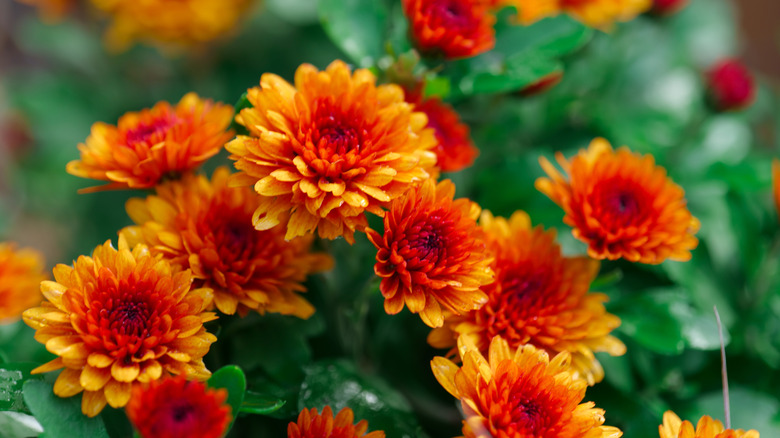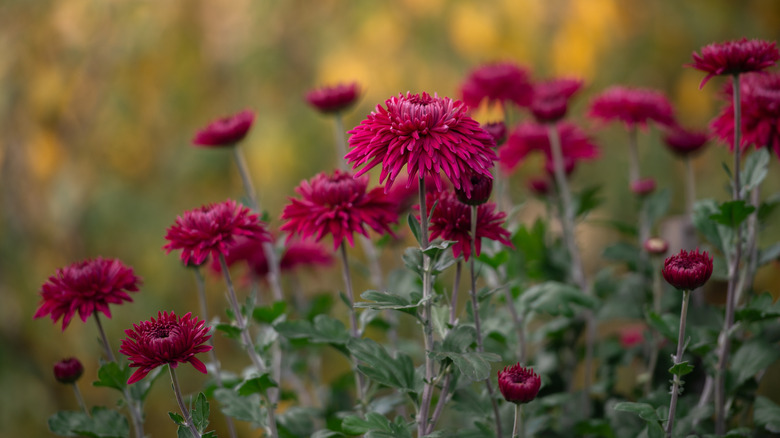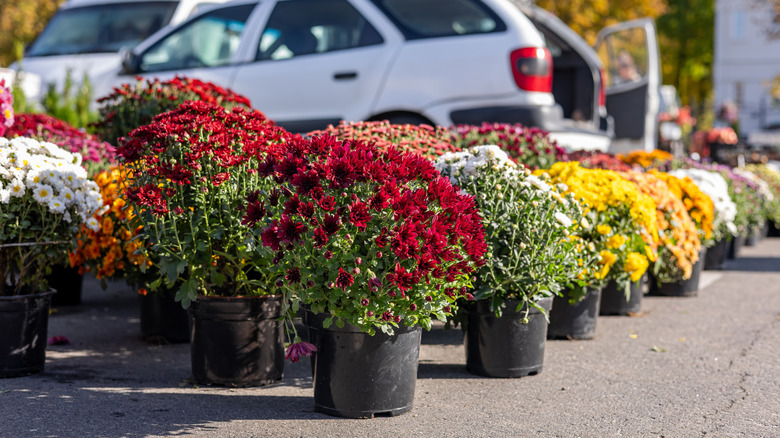Garden Mums Vs Florist Mums: What's The Difference? (& Why It Matters)
As the air grows crisp and the leaves shift crimson red and orange, chrysanthemums (Chrysanthemum x morifolium) make their return as the hallmark flower of the fall season. Better known as mums, this daisy-like bloom comes in a variety of colors and attracts butterflies as a late-season nectar source. Mums are categorized in two distinct varieties: garden mums and florist mums. While garden mums are considered perennials, florist mums are typically sold in pots as annuals. Both varieties require different care so it's vital to know the difference between them.
While garden mums, also known as hardy mums, come back year after year, florist mums are specifically bred to bloom for one season alone. You'll often see displays dotted with florist mums during the fall at your local grocery store or garden center. Another easy way to tell these mum varieties apart is by taking a closer look at their blooms. You can barely see the foliage of a florist mum due to its abundance of flowers. Conversely, garden mums have larger blooms but a lot less of them. There are some similarities in care for these two varieties. Both require about 6 hours of sunshine a day and moist, well-drained soil to thrive. There are, however, several key differences to be aware of as well.
Caring for your garden mums
You'll often see garden mums on sale among other perennials in the spring. They are suitable to plant directly in your garden in USDA Hardiness zones 5 to 9. Once established, garden mums can grow to be 3 feet tall and 2 feet wide. In order to get the most out of your garden mums, it's crucial to establish them in the spring after the last frost. In this time, it can expend energy establishing underground shoots called stolons that help the plant survive the winter. Be sure to plant your mum in well-drained soil with plenty of room for their roots to grow. Consider planting them with slow-release granular fertilizer for richer soil. If you do choose to plant your mum in the fall while it's blooming, the plant won't have enough energy to establish a strong root system and likely won't survive colder months. However, you can attempt to insulate the roots with straw or evergreen boughs to protect it from freezing temperatures.
A healthy garden mum should bloom for up to eight weeks. To give your garden mum a better chance at growing big and bushy, consider pinching off the stem ends once your plant reaches roughly 6 inches tall. Fertilize with water-soluble, 10-10-10 fertilizer once a week until late-summer. Steer clear of fertilizing once your plant starts to bloom—this can promote excess vegetative growth and leave it more vulnerable in the winter. Be sure to keep the topsoil moist. You can also deadhead old blooms to promote more growth. At the end of the season, cut stems down to about 8 inches to prepare for overwintering. If you live in a colder climate, consider storing your mums and keeping them in a dark, cool place until spring.
Caring for your florist mums
Florist mums, also known as pot mums, are the variety you'll see in containers at your local pumpkin patch or lining the porches of every other home in your neighborhood. While they are technically the same species as the garden mum, they're bred in pots to produce more flowers. Without space to establish a robust root system, they're forced to expend energy on bloom growth instead. At their peak, these potted plants can grow 1 to 2 feet tall and roughly the same width. Florist mums come in a variety of colors and bloom styles but tend to be a bit more fragile than their garden counterparts. There are, however, some ways to fortify your pot mums.
When selecting your florist mums, go for a plant with plenty of closed buds for a better chance of enjoying its blooms all fall. They should bloom roughly six to eight weeks when properly tended to. Most florist mums will be significantly root bound upon purchase so it's a good idea to repot the plant with fresh soil when you bring it home. Opt for rich, well-drained soil and amend with organic matter. Further supplement with diluted liquid fertilizer about once a week. You should water your florist mums at least once a day—especially when it's hot. Deadhead old blooms to promote more flower growth. Keep in mind that even with proper repotting, florist mums tend to have shallow roots that make it difficult for them to survive through the winter. They are considered hardy in USDA Hardiness zones 7 to 9, but even still, they are unlikely to return next year. So enjoy the beautiful blooms while you can!


